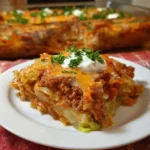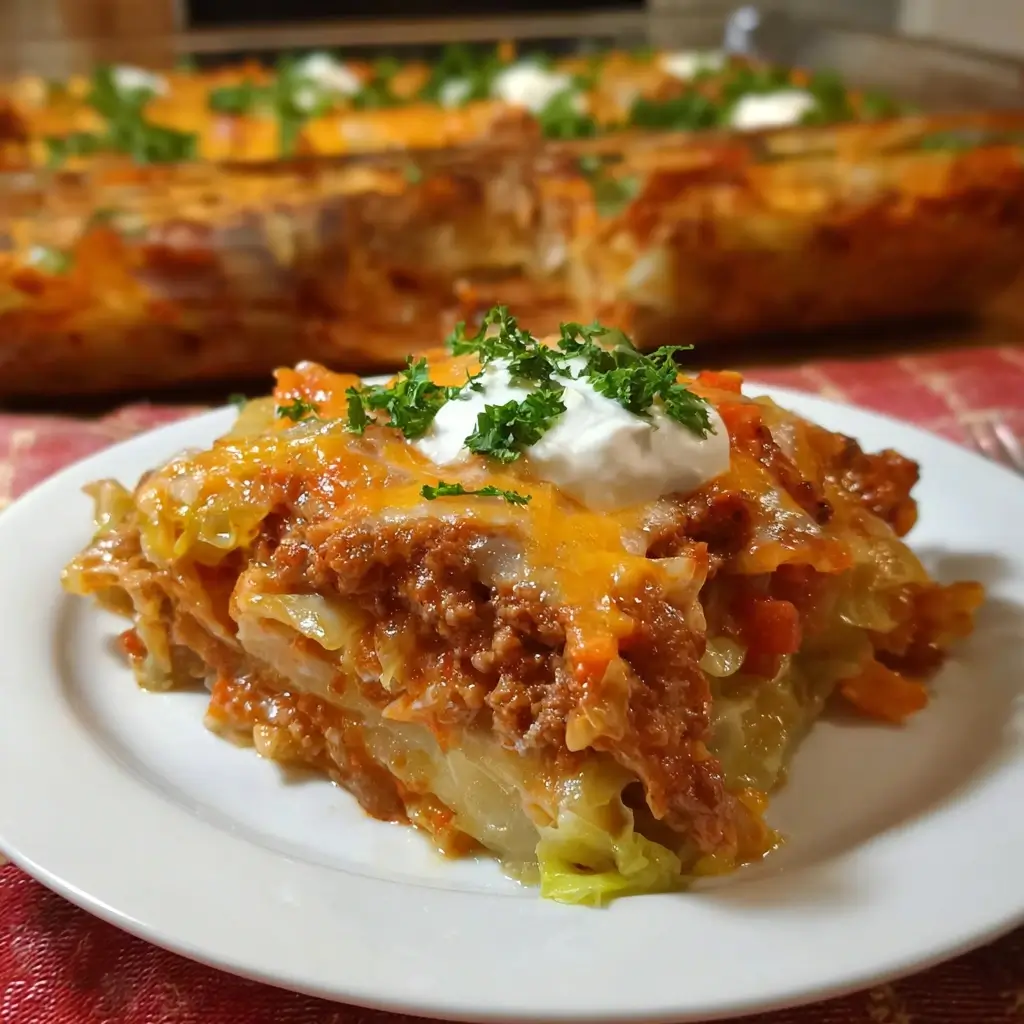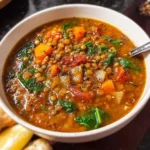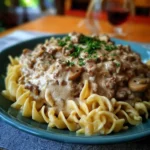Of all the comfort foods that grace our family table, there are few that elicit the same unanimous cheer as this Cabbage Roll Casserole. For years, I adored the idea of traditional cabbage rolls—the savory filling, the tender cabbage leaves, the rich tomato sauce—but the reality of a busy household often made the meticulous process of blanching, stuffing, and rolling individual leaves feel like a culinary marathon I just didn’t have the stamina for. Then, this recipe entered our lives, a true game-changer. It’s the deconstructed, laid-back cousin of the classic, delivering every ounce of the heartwarming, nostalgic flavor with a fraction of the effort. The first time I served it, a hush fell over the dinner table, quickly followed by the clinking of forks and murmurs of “Wow, this is amazing.” My kids, who sometimes approach new vegetable-heavy dishes with suspicion, devoured it without a second thought. It has since become our go-to for chilly evenings, potlucks, and any time we crave a meal that feels like a cozy embrace in a dish. It’s a testament to the fact that incredible food doesn’t have to be complicated, and the best meals are often the ones that bring everyone together with ease and pure, unadulterated deliciousness.
The Ultimate Cabbage Roll Casserole Recipe
This recipe simplifies the beloved classic into a hearty, layered bake. Before we get to the instructions, let’s take a moment to understand the key players in this dish. Each ingredient is chosen to build layers of flavor, resulting in a perfectly balanced and satisfying meal.
A Deep Dive into the Ingredients:
The magic of this casserole lies in the synergy of its simple, wholesome components. Understanding their role will help you perfect the dish and even customize it to your liking.
- The Ground Meat: We’re using lean ground beef, typically an 85/15 or 90/10 blend. The fat renders during cooking, infusing the entire casserole with a rich, beefy flavor that is central to the classic cabbage roll taste. The browning process is crucial; it’s not just about cooking the meat but about creating the Maillard reaction—that deep, savory crust that translates into profound flavor. Don’t be afraid to let it get some nice color in the pan. While beef is traditional, ground pork adds a wonderful sweetness and tenderness, while ground turkey or chicken can be used for a lighter alternative. A combination of beef and pork is a secret weapon for many chefs, offering the best of both worlds.
- The Cabbage: A medium to large head of green cabbage is the star. Its mild, slightly sweet flavor becomes incredibly tender and succulent as it bakes in the tomato sauce. When you chop the cabbage, you’re creating more surface area, allowing it to soften beautifully and absorb all the surrounding flavors. You don’t need to blanch it beforehand, which is one of the biggest time-savers in this recipe. The moisture released from the cabbage during baking is essential; it steams the rice and melds the layers together. Savoy cabbage is a great alternative, with a slightly more delicate texture and crinkly leaves that look beautiful in the casserole.
- The Rice: Long-grain white rice provides the perfect texture. We cook it beforehand to ensure it’s perfectly tender and doesn’t end up crunchy or absorb too much liquid, which can dry out the casserole. Cooking the rice separately gives you complete control over its final texture. While you can technically use uncooked rice, it requires adjusting the liquid content and bake time, which can be tricky. Sticking with pre-cooked rice is the most reliable path to success. For a healthier, nuttier flavor, you can substitute brown rice, but be sure to cook it according to its package directions, as it takes longer than white rice.
- The Aromatics: Yellow onion and garlic are the non-negotiable foundation of flavor. Sautéing them until soft and translucent tames their raw bite and coaxes out a deep, aromatic sweetness that permeates every layer of the dish. This initial step is vital for building a complex flavor profile that goes beyond just meat and tomato.
- The Tomato Base: A combination of tomato sauce and diced tomatoes creates a dynamic and textured sauce. The smooth tomato sauce provides the liquid base that brings everything together, while the diced tomatoes add little bursts of bright, fresh tomato flavor and a more rustic texture. We enhance this base with tomato paste, a highly concentrated source of umami that adds incredible depth and richness to the sauce.
- The Seasonings: The seasoning blend is what truly evokes the spirit of Eastern European cabbage rolls. Sweet paprika lends a vibrant color and a mild, sweet pepper flavor. Dried thyme adds an earthy, slightly minty note that pairs beautifully with both the beef and the cabbage. A pinch of brown sugar might seem unusual, but it’s a crucial balancing act. It doesn’t make the dish sweet; instead, it cuts through the acidity of the tomatoes, creating a smoother, more well-rounded sauce. And of course, salt and black pepper are essential for enhancing all the other flavors.
Complete Ingredient List:
- 2 lbs lean ground beef (85/15 or 90/10)
- 1 large yellow onion, chopped
- 4 cloves garlic, minced
- 1 medium-large head of green cabbage (about 3-4 lbs), cored and chopped
- 1 ½ cups long-grain white rice, cooked according to package directions
- 1 (28 ounce) can tomato sauce
- 1 (15 ounce) can diced tomatoes, undrained
- 3 tablespoons tomato paste
- 1 cup beef broth
- 2 teaspoons sweet paprika
- 1 teaspoon dried thyme
- 1 tablespoon brown sugar (optional, to balance acidity)
- 2 teaspoons salt, or to taste
- 1 teaspoon black pepper, or to taste
- 2 tablespoons olive oil
- For garnish (optional): Fresh parsley or dill, chopped; sour cream or plain Greek yogurt
Step-by-Step Instructions for Casserole Perfection
Follow these detailed steps to build your casserole. The key is to develop flavor in stages, ensuring each component is perfectly prepared before being combined.
Phase 1: Preparation is Key
- Preheat and Prep Your Dish: First, preheat your oven to 375°F (190°C). Lightly grease a large 9×13 inch baking dish or a deep 3-quart casserole dish. This prevents the bottom layer from sticking and makes for easier cleanup.
- Cook the Rice: If you haven’t already, cook your rice according to the package directions. Once cooked, fluff it with a fork and set it aside. This step is often done first so the rice is ready when you need it.
- Prep the Vegetables: Core the head of cabbage and chop it into bite-sized pieces, about 1-inch squares. Don’t worry about perfection; it will all cook down beautifully. Chop your onion and mince your garlic. Having all your ingredients prepped and ready (a process known as “mise en place”) makes the cooking process smooth and stress-free.
Phase 2: Building the Flavor Base
- Brown the Beef: Heat the olive oil in a large skillet or Dutch oven over medium-high heat. Add the ground beef to the hot pan. Break it up with a spoon and cook until it’s thoroughly browned, about 7-10 minutes. This browning step is crucial for developing deep, savory flavor. Drain off any excess grease, leaving about a tablespoon in the skillet for flavor, and transfer the browned beef to a large mixing bowl.
- Sauté the Aromatics: In the same skillet, add the chopped onion. Sauté for 5-7 minutes, stirring occasionally, until it has softened and become translucent. Add the minced garlic and cook for another minute until fragrant. Be careful not to burn the garlic, as it can become bitter. This process of cooking the onions and garlic unlocks their sweetness and forms the aromatic foundation of your sauce.
Phase 3: Creating the Rich Tomato Sauce
- Combine Sauce Ingredients: To the skillet with the onions and garlic, add the tomato sauce, undrained diced tomatoes, tomato paste, beef broth, sweet paprika, dried thyme, brown sugar (if using), salt, and pepper.
- Simmer and Meld: Stir everything together until the tomato paste is fully incorporated. Bring the sauce to a gentle simmer and let it cook for about 5 minutes. This allows the flavors to meld together into a cohesive, rich sauce. Taste the sauce at this point and adjust the salt and pepper if needed.
Phase 4: Assembling Your Cabbage Roll Casserole
- Combine the Filling: In the large bowl with the browned beef, add the cooked rice and about one-third (approximately 1 ½ cups) of your prepared tomato sauce. Mix everything together until the beef and rice are evenly coated in the sauce. This is your hearty filling layer.
- Layer the Casserole: Now it’s time to build the casserole in your prepared baking dish. This layering technique ensures that every bite has the perfect ratio of ingredients.
- First Layer (Cabbage): Spread half of your chopped cabbage evenly across the bottom of the dish.
- Second Layer (Filling): Spoon the entire beef and rice mixture over the cabbage, spreading it into an even layer.
- Third Layer (Cabbage): Top the filling with the remaining half of the chopped cabbage.
- Final Layer (Sauce): Pour the rest of the tomato sauce evenly over the top layer of cabbage, ensuring it covers everything.
Phase 5: Baking to Bubbly Perfection
- Cover and Bake: Cover the baking dish tightly with aluminum foil. This is a critical step, as it traps the steam inside, which cooks the cabbage until it’s perfectly tender.
- Initial Bake: Place the casserole in the preheated 375°F oven and bake for 60 minutes.
- Uncover and Finish: After 60 minutes, carefully remove the foil. The cabbage should be significantly wilted and tender. Return the casserole to the oven, uncovered, and bake for an additional 20-30 minutes. This final, uncovered baking time allows the sauce to thicken and reduce slightly, and the top to get beautifully caramelized in spots. The casserole is done when it’s bubbly and the cabbage is fork-tender.
- Rest Before Serving: Remove the casserole from the oven and let it rest on a cooling rack for at least 10-15 minutes before serving. This crucial resting period allows the casserole to set, making it easier to slice and serve. It also prevents the molten-hot sauce from burning eager mouths!
Nutrition Facts
- Servings: 8-10 servings
- Calories per serving: Approximately 450-550 kcal (This is an estimate and can vary based on the leanness of the ground beef and other specific ingredients used.)
Preparation Time
- Prep Time: 25 minutes
- Cook Time: 1 hour 30 minutes
- Total Time: 1 hour 55 minutes
How to Serve
This Cabbage Roll Casserole is a complete meal in itself, but serving it with the right accompaniments can elevate the entire experience. Here are some wonderful ways to present and enjoy your dish:
- The Classic Dollop:
- Serve each portion warm with a generous dollop of full-fat sour cream or thick plain Greek yogurt. The cool, tangy creaminess provides a perfect contrast to the rich, savory tomato sauce.
- A Sprinkle of Fresh Herbs:
- Brighten up the dish with a sprinkle of fresh, chopped herbs just before serving.
- Fresh Dill: Its slightly anise-like flavor is a classic pairing in Eastern European cuisine and beautifully complements the cabbage.
- Fresh Parsley: Adds a clean, green, peppery note that cuts through the richness.
- Fresh Chives: Provides a delicate, mild onion flavor.
- Perfect Side Dish Pairings:
- Crusty Bread: Serve with slices of crusty sourdough, rye bread, or a simple baguette for mopping up every last bit of the delicious sauce.
- Mashed Potatoes: For an ultimate comfort food experience, serve the casserole alongside or on top of a bed of creamy mashed potatoes.
- A Simple Green Salad: A crisp salad with a light vinaigrette offers a refreshing counterpoint to the hearty casserole. Think mixed greens, cucumber, and a simple lemon-dijon dressing.
- Roasted Root Vegetables: A side of roasted carrots or parsnips can add a touch of sweetness and another layer of texture.
Additional Tips for a Perfect Casserole
- Manage the Moisture: Cabbage releases a lot of water as it cooks. To prevent a watery casserole, you can lightly salt the chopped cabbage in a colander and let it sit for 20-30 minutes before assembling. This will draw out excess moisture. Pat it dry with paper towels before adding it to the dish. Alternatively, ensure your sauce is thick and rich, and remember that the final 20-30 minutes of uncovered baking time is key to reducing any excess liquid.
- Boost the Flavor Profile: Don’t be afraid to enhance the sauce. A tablespoon of Worcestershire sauce adds a fantastic umami depth. A bay leaf tossed into the sauce while it simmers (and removed before assembling) imparts a subtle, savory aroma. For a smoky twist, substitute half of the sweet paprika with smoked paprika.
- Make-Ahead Magic for Busy Nights: This casserole is a perfect make-ahead meal. You can assemble the entire casserole up to 24 hours in advance. Simply cover it tightly with plastic wrap or foil and refrigerate. When you’re ready to cook, remove it from the fridge for 30 minutes to take the chill off, then bake as directed, adding about 10-15 minutes to the initial covered baking time.
- Cheese, Please! A Cheesy Topping: For an extra layer of decadent flavor and texture, add a cheesy topping. During the last 15 minutes of the uncovered baking time, sprinkle 1 to 1 ½ cups of shredded cheese over the top. Good choices include:
- Sharp Cheddar: For a bold, tangy flavor.
- Mozzarella: For that classic, melty cheese pull.
- Gruyère: For a nutty, complex flavor that melts beautifully.
- The Importance of Resting: We mentioned it in the instructions, but it bears repeating. Do not skip the resting period! Letting the casserole sit for at least 10-15 minutes after it comes out of the oven is essential. It allows the liquid to be reabsorbed and the layers to set. Slicing into it immediately will result in a soupy pile on the plate. Patience will reward you with clean, beautiful servings.
Frequently Asked Questions (FAQ)
1. Can I make this with ground turkey or chicken?
Absolutely! This recipe is very flexible. If using ground turkey or chicken, opt for a blend that isn’t overly lean (like 93/7) to ensure it stays moist. Since poultry is milder in flavor than beef, you may want to add a bit more seasoning, like an extra teaspoon of paprika or a pinch of red pepper flakes for a little kick. Adding a tablespoon of soy sauce or Worcestershire sauce during the browning process can also help boost the umami flavor.
2. How do I store and reheat leftovers?
Leftovers are fantastic, as the flavors continue to meld overnight. Store any remaining casserole in an airtight container in the refrigerator for up to 4 days. To reheat, you can microwave individual portions for 2-3 minutes until hot. For best results, reheat a larger portion in an oven-safe dish at 350°F (175°C) for 20-25 minutes, or until warmed through. Covering it with foil will prevent it from drying out.
3. Can I freeze Cabbage Roll Casserole?
Yes, this casserole freezes beautifully, making it an excellent meal prep option. You can freeze it baked or unbaked.
- To Freeze Unbaked: Assemble the casserole as directed in a freezer-safe dish (like an aluminum foil pan). Cover it tightly with a layer of plastic wrap, followed by a layer of aluminum foil. It can be frozen for up to 3 months. To bake, thaw it overnight in the refrigerator and bake as directed, adding 15-20 minutes to the covered baking time.
- To Freeze Baked: Let the cooked casserole cool completely. You can freeze it whole or in individual portions. Wrap it tightly and freeze for up to 3 months. Thaw overnight in the refrigerator and reheat in the oven or microwave.
4. My casserole turned out watery. What did I do wrong?
A watery casserole is a common issue and usually has a couple of culprits. First, the cabbage itself releases a significant amount of liquid. As mentioned in the tips, you can pre-salt the cabbage to draw out moisture. Second, ensure you didn’t add too much liquid to begin with (e.g., using a very thin beef broth or watery tomato sauce). Finally, the uncovered baking time at the end is crucial for allowing excess liquid to evaporate and the sauce to thicken. If it’s still a bit loose, just let it rest for a longer period (20-25 minutes) before serving; it will continue to set up as it cools.
5. Can I use uncooked rice to save a step?
While technically possible, it’s not recommended for this specific recipe as it changes the dynamics significantly. Uncooked rice will absorb a lot of liquid from the sauce and cabbage. To make it work, you would need to increase the liquid in the recipe (likely by adding another 1 to 1.5 cups of beef broth or water) and extend the baking time. The results can be inconsistent, sometimes leading to crunchy rice or a dry casserole. For foolproof, perfectly textured results every time, using pre-cooked rice is the safest and most reliable method.

Cabbage Roll Casserole Recipe
Ingredients
- 2 lbs lean ground beef (85/15 or 90/10)
- 1 large yellow onion, chopped
- 4 cloves garlic, minced
- 1 medium-large head of green cabbage (about 3–4 lbs), cored and chopped
- 1 ½ cups long-grain white rice, cooked according to package directions
- 1 (28 ounce) can tomato sauce
- 1 (15 ounce) can diced tomatoes, undrained
- 3 tablespoons tomato paste
- 1 cup beef broth
- 2 teaspoons sweet paprika
- 1 teaspoon dried thyme
- 1 tablespoon brown sugar (optional, to balance acidity)
- 2 teaspoons salt, or to taste
- 1 teaspoon black pepper, or to taste
- 2 tablespoons olive oil
- For garnish (optional): Fresh parsley or dill, chopped; sour cream or plain Greek yogurt
Instructions
Phase 1: Preparation is Key
- Preheat and Prep Your Dish: First, preheat your oven to 375°F (190°C). Lightly grease a large 9×13 inch baking dish or a deep 3-quart casserole dish. This prevents the bottom layer from sticking and makes for easier cleanup.
- Cook the Rice: If you haven’t already, cook your rice according to the package directions. Once cooked, fluff it with a fork and set it aside. This step is often done first so the rice is ready when you need it.
- Prep the Vegetables: Core the head of cabbage and chop it into bite-sized pieces, about 1-inch squares. Don’t worry about perfection; it will all cook down beautifully. Chop your onion and mince your garlic. Having all your ingredients prepped and ready (a process known as “mise en place”) makes the cooking process smooth and stress-free.
Phase 2: Building the Flavor Base
- Brown the Beef: Heat the olive oil in a large skillet or Dutch oven over medium-high heat. Add the ground beef to the hot pan. Break it up with a spoon and cook until it’s thoroughly browned, about 7-10 minutes. This browning step is crucial for developing deep, savory flavor. Drain off any excess grease, leaving about a tablespoon in the skillet for flavor, and transfer the browned beef to a large mixing bowl.
- Sauté the Aromatics: In the same skillet, add the chopped onion. Sauté for 5-7 minutes, stirring occasionally, until it has softened and become translucent. Add the minced garlic and cook for another minute until fragrant. Be careful not to burn the garlic, as it can become bitter. This process of cooking the onions and garlic unlocks their sweetness and forms the aromatic foundation of your sauce.
Phase 3: Creating the Rich Tomato Sauce
- Combine Sauce Ingredients: To the skillet with the onions and garlic, add the tomato sauce, undrained diced tomatoes, tomato paste, beef broth, sweet paprika, dried thyme, brown sugar (if using), salt, and pepper.
- Simmer and Meld: Stir everything together until the tomato paste is fully incorporated. Bring the sauce to a gentle simmer and let it cook for about 5 minutes. This allows the flavors to meld together into a cohesive, rich sauce. Taste the sauce at this point and adjust the salt and pepper if needed.
Phase 4: Assembling Your Cabbage Roll Casserole
- Combine the Filling: In the large bowl with the browned beef, add the cooked rice and about one-third (approximately 1 ½ cups) of your prepared tomato sauce. Mix everything together until the beef and rice are evenly coated in the sauce. This is your hearty filling layer.
- Layer the Casserole: Now it’s time to build the casserole in your prepared baking dish. This layering technique ensures that every bite has the perfect ratio of ingredients.
- First Layer (Cabbage): Spread half of your chopped cabbage evenly across the bottom of the dish.
- Second Layer (Filling): Spoon the entire beef and rice mixture over the cabbage, spreading it into an even layer.
- Third Layer (Cabbage): Top the filling with the remaining half of the chopped cabbage.
- Final Layer (Sauce): Pour the rest of the tomato sauce evenly over the top layer of cabbage, ensuring it covers everything.
Phase 5: Baking to Bubbly Perfection
- Cover and Bake: Cover the baking dish tightly with aluminum foil. This is a critical step, as it traps the steam inside, which cooks the cabbage until it’s perfectly tender.
- Initial Bake: Place the casserole in the preheated 375°F oven and bake for 60 minutes.
- Uncover and Finish: After 60 minutes, carefully remove the foil. The cabbage should be significantly wilted and tender. Return the casserole to the oven, uncovered, and bake for an additional 20-30 minutes. This final, uncovered baking time allows the sauce to thicken and reduce slightly, and the top to get beautifully caramelized in spots. The casserole is done when it’s bubbly and the cabbage is fork-tender.
- Rest Before Serving: Remove the casserole from the oven and let it rest on a cooling rack for at least 10-15 minutes before serving. This crucial resting period allows the casserole to set, making it easier to slice and serve. It also prevents the molten-hot sauce from burning eager mouths!
Nutrition
- Serving Size: One Normal Portion
- Calories: 450-550 kcal





